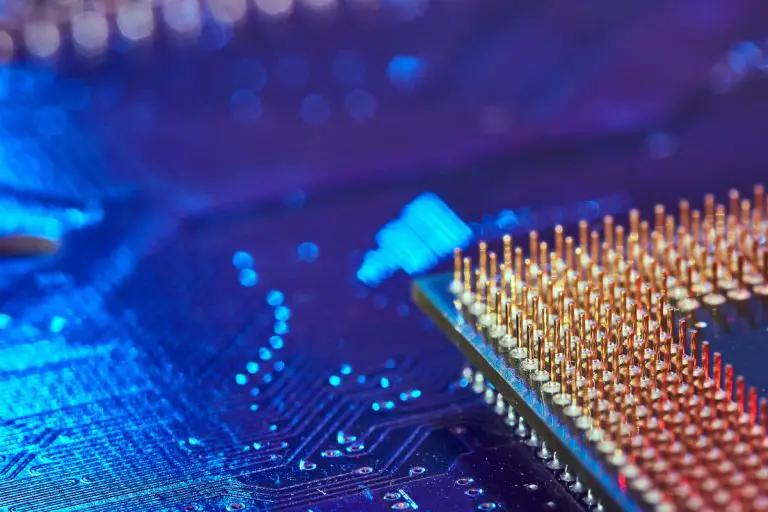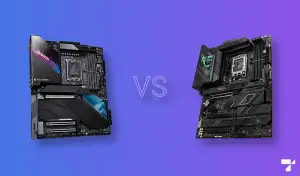If you are considering an Intel processor, you may have stumbled across suffixes like K, KF, and F, which were absent from previous generations. Though confusing at first, we have prepared a comprehensive guide explaining the differences between Intel’s K, KF, and F processors.
Differences Between the K, KF, and F Intel Processors
The K means that the Intel processor is unlocked and can be overclocked for maximum performance. While the F means that the intel processor lacks integrated graphics or iGPU. The primary difference between the K and KF series processors is the lack of an iGPU in the KF series processors to provide a slightly lower cost than the K series processors. Though both the K and KF chips offer the same amount of cores, clock speed, and performance.
The F series Intel processors lack integrated graphics which makes them cheaper but are generally identical to the non-K series processors in performance, with both having a locked multiplier. Additionally, there are also Intel KS processors which are “Special Edition” higher binned K processors with increased performance providing higher base clock speeds but at a slightly higher cost.
Video Explaining Intel CPU Letters
Intel K Meaning
First, we start with the Intel K series processors. The K suffix means that the chip is unlocked, allowing for features like overclocking, which would enable you to push the processor to its limits to squeeze out every little bit of performance. But to make use of such features, you will also need a specially designed motherboard supporting overclocking and an excellent cooling system, preferably liquid cooling, as overclocking results in higher temperatures, which might be too much for some lower-end air cooling solutions.
Overclocking a processor also needs a thorough knowledge of the different settings available in your computer’s BIOS. A majority of buyers who opt for the K series processors are enthusiasts aiming to make the most out of the CPU’s abilities. It is not recommended to choose from this processor range if you don’t plan on overclocking since the price difference is quite significant between the K and non-K processor types.
Intel KF Meaning
We now move on to the KF series of processors. These chips are identical in all aspects to their K counterparts, except for the lack of integrated graphics to reduce costs. The absence of iGPU means that you will need to employ the use of a dedicated graphics card like Nvidia’s GTX 1650 as a monitor needs a graphics processor to give a video output.
This is especially problematic if you intend to use these processors by themselves. However, if you are planning to pair such a CPU with a graphics card for gaming or content creation purposes, it might seem to be the right choice.
But by scraping the iGPU, your desktop will be running the discrete graphics continuously, which will inadvertently lead to slightly more power consumption, higher temperatures, and a lower graphic card lifespan. Also, keep in mind that features like QuickSync used by Adobe applications will not work since they depend on the iGPU.
Intel F Meaning
The F series range of processors is basically the multiplier-locked version of the KF processors. Also, lacking an iGPU, these processors will need a dedicated GPU to run. Though the multiplier seems locked, it is possible to lock all cores at a high frequency and play around with the BCLK settings for a performance gain.
This will prove to be more complicated since you will need to know what you are doing, and there is the risk of corrupting your system. Nevertheless, these processors have the same boost clocks as the KF series but can sometimes have a lower base clock.
Intel KS Meaning
Intel KS processors are higher binned CPUs that overperform other K series processors in their same class or spec. This is because CPU production doesn’t yield 100 percent consistent results therefore, some CPUs perform considerably better or worse than others after being produced.
For example, a 12900K CPU that provides considerably better performance with higher base clock speeds than another 12900K CPU is given the KS designation. Basically, KS intel CPUs are higher-performing versions of normal intel K processors.
Intel Non-K, KF, and F Processors
Finally, we discuss the options available other than the ones listed above. The first kind of processor is the Non-K lineup of Core processors. These processors lack overclocking capabilities but come with an integrated GPU, unlike the F series processors. These processors are best suited for light workloads, which do not make use of a dedicated graphics card.
Another series of processors is the Core X series of desktop processors. These processors offer the ultimate performance and best overclocking capabilities but come at very high prices. These are aimed at tech enthusiasts who want the ultimate experience in their respective workloads.
Intel K vs KF for Gaming
If you are deciding on whether to utilize an intel K vs KF CPU for gaming, the KF CPU is a cheaper option that will provide you with the same gaming performance as a K CPU. This is because both the K and KF CPUs have the same specs in terms of core count, clock speed, etc., but the KF CPU lacks integrated graphics which makes it slightly cheaper. Therefore, you will get the same gaming performance with an intel KF CPU as you would form an intel K CPU when using a dedicated graphics card.
However, though the integrated graphics on an Intel K CPU might seem redundant, the lack of integrated graphics on the KF CPU may come into play if your GPU dies. This is because if you are using a KF CPU and your GPU dies, you won’t be able to use your PC until you acquire a new GPU. So if you are on a budget the KF CPU is ideal for your gaming and other computational needs, but if you want peace of mind in case your GPU fails, then you should consider spending a bit more for a K CPU.
Final Thoughts
If you are in the market for an Intel processor, our first suggestion is that you be confident of your intended use cases. If you want a cheaper processor for basic computing and productivity workloads, and don’t plan to do much gaming or any computational tasks that require a discrete GPU, we recommend the f series, for their relatively low price and the inclusion of an integrated GPU. Preferably choose the i5 variant for a more optimal price-to-performance ratio or the i3 variant if on a budget.
If you want to invest in a desktop for heavier workloads and gaming, we would recommend the K or kF series processors, preferably the i7 option though an i5 will suffice, and a good discrete GPU. Both, the K and KF series processors would also be great if overclocking is your thing to get some extra performance.
We also recommend the i9 option of the K family if you want a step up in performance over the i7. The K and KF i9s are almost the same price, and the added advantage of the iGPU should not be ignored here. Make sure you have a great graphics card to pair it up for the best performance.
Finally, if you are an Intel pc enthusiast, the X series of processors provide the best overclocking capabilities and cores among any Intel CPU. Only buy this if you are absolutely sure you need one or if you are a tech enthusiast wanting to try out the best. You can learn more about Intel processor names, numbers, and letters here.



